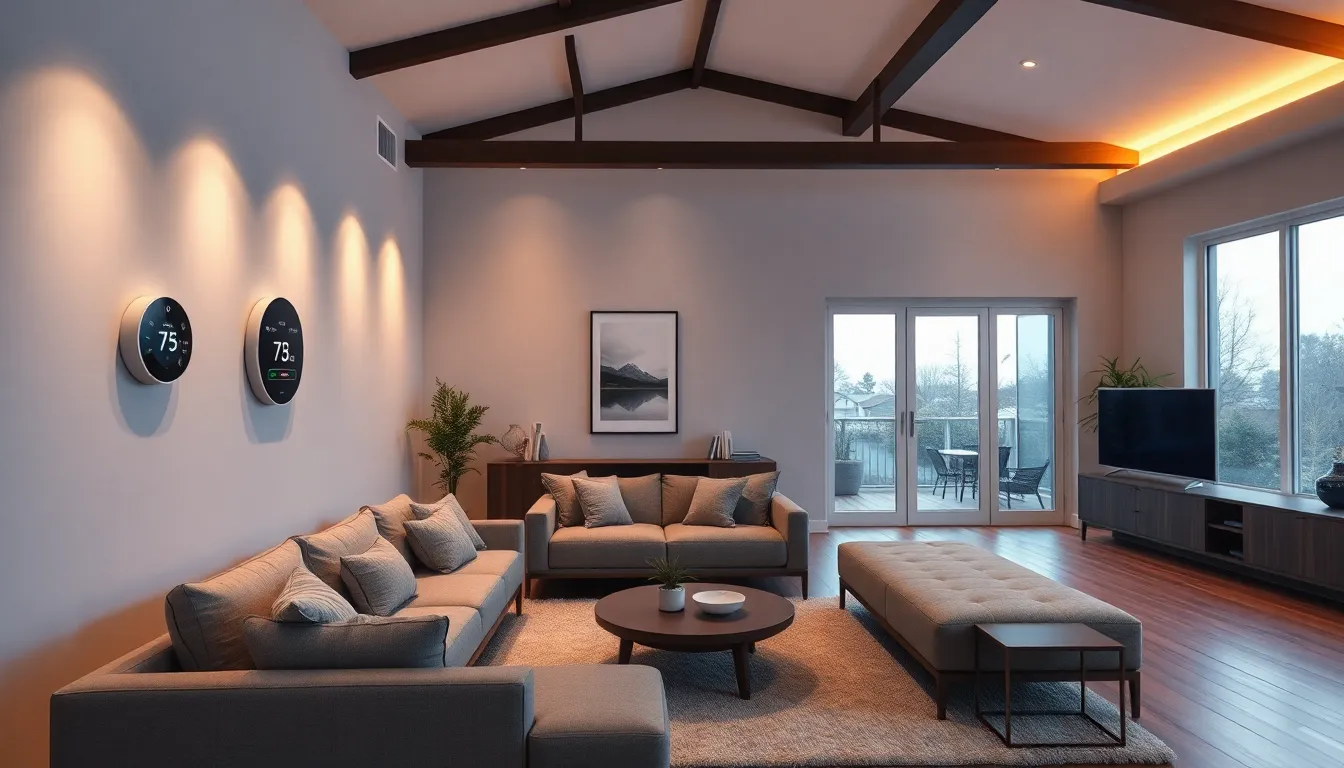In today’s fast-paced world, ambient home technology is transforming the way people interact with their living spaces. This innovative approach seamlessly integrates smart devices into everyday life, creating an environment that adapts to individual needs and preferences. From smart lighting that adjusts with the time of day to voice-activated assistants that manage tasks, ambient technology enhances comfort and convenience.
As homes become smarter, the focus shifts from mere automation to creating a harmonious atmosphere that promotes well-being. This technology not only simplifies daily routines but also enriches the home experience, making it more intuitive and personalized. Understanding the benefits and possibilities of ambient home technology can empower homeowners to create spaces that truly reflect their lifestyles.
Table of Contents
ToggleOverview of Ambient Home Technology
Ambient home technology refers to the integration of intelligent devices and systems that create a responsive, user-friendly environment. This technology focuses on enhancing daily experiences by making homes more adaptive to individual needs.
Key Components
- Smart Lighting: Automatically adjusts brightness and color temperature based on time of day or user preferences.
- Voice Assistants: Enabled devices respond to vocal commands, allowing seamless control of home functions.
- Temperature Control Systems: Smart thermostats optimize heating and cooling based on occupancy patterns, improving energy efficiency.
- Security Systems: Innovative security cameras and alarms provide real-time monitoring and alerts, enhancing peace of mind.
- Smart Appliances: Kitchen and laundry devices can be programmed remotely, improving convenience and efficiency.
Benefits
- Enhanced Comfort: Ambient technology allows for customization of the living space according to personal comfort levels.
- Energy Efficiency: Integrated systems monitor usage patterns, reducing waste and lowering utility costs.
- Improved Accessibility: Voice controls and automation features create greater accessibility for individuals with mobility challenges.
- Personalization: Customizable settings allow homeowners to create environments that reflect their unique lifestyle and preferences.
Ambient home technology facilitates a harmonious atmosphere, promoting well-being through thoughtful integration of devices. It goes beyond mere automation, offering a holistic approach to modern living.
Benefits of Ambient Home Technology

Ambient home technology offers numerous advantages that significantly enhance residential living experiences. Two primary benefits include enhanced convenience and improved energy efficiency.
Enhanced Convenience
Ambient home technology streamlines daily activities, making interactions with living spaces effortless. Smart devices allow users to control lighting, temperature, and appliances through voice commands or smartphone apps. For example, smart thermostats adjust temperatures based on established preferences, while smart lighting systems enable users to set scenes for different times of day. Additionally, these technologies can automate routine tasks, such as setting reminders or scheduling appliance usage, improving overall household organization.
Improved Energy Efficiency
Ambient home technology contributes to substantial energy savings by optimizing resource usage. Smart lighting systems automatically dim or turn off when rooms are unoccupied, reducing electricity consumption. Programmable thermostats learn user preferences and adjust heating or cooling accordingly, significantly lowering energy bills. Furthermore, energy-efficient appliances, integrated into smart home systems, consume less power while delivering improved performance. By creating an intelligent environment focused on efficiency, homeowners reduce their carbon footprint and promote sustainable living practices.
Key Features to Look For
Choosing the right ambient home technology involves considering key features that enhance functionality and user experience. Below are essential aspects to prioritize.
Smart Integration
Smart integration remains critical for seamless device connectivity. Look for systems that easily connect with various smart home platforms, such as Amazon Alexa, Google Assistant, or Apple HomeKit. Assess compatibility with multiple devices, ensuring that lighting, heating, and security systems work together efficiently. Prioritize technologies that can automate routines; for example, an integrated system could lower blinds, adjust lighting, and set the thermostat at designated times each day. This integration provides a holistic approach to managing home environments seamlessly.
User-Friendly Interfaces
User-friendly interfaces serve as a foundation for successful ambient home technology. Opt for systems with intuitive controls, whether through mobile apps or voice commands, making operation accessible to all users. Evaluate visual design and ease of navigation; simple layouts enhance usability. Consider features like smart displays, touch panels, or voice-activated systems that respond quickly to commands. A streamlined interface promotes engagement, making technology an effortless part of daily living.
Popular Ambient Home Technology Products
Ambient home technology includes various innovative products that enhance living spaces. These products create a comfortable, efficient environment by integrating smart devices seamlessly into daily life.
Smart Speakers
Smart speakers serve as central hubs for home automation. Devices, such as Amazon Echo and Google Nest, provide voice-activated control for other smart devices. Users can adjust lighting, control music, or check the weather with simple voice commands. Many smart speakers feature built-in assistants, enabling users to access information, set reminders, or manage tasks effortlessly.
Smart Lighting Solutions
Smart lighting solutions significantly improve ambiance and energy efficiency. Products like Philips Hue and LIFX offer adjustable brightness and color settings to suit different moods and activities. Users can schedule lighting to automatically adjust throughout the day, enhancing comfort and convenience. Integration with voice assistants allows for hands-free control, while motion sensors detect activity, ensuring lights turn on and off as needed. Additionally, these systems contribute to energy savings by using LED technology, consuming less power than traditional bulbs.
Future Trends in Ambient Home Technology
Ambient home technology continues to evolve, with several notable trends shaping its future landscape.
- AI-Powered Personalization
AI-driven systems offer enhanced customization options. Smart homes learn user preferences over time, adapting lighting, temperature, and music to suit individual needs. This level of personalization creates a more intuitive living environment.
- Integration of IoT Devices
Increased connectivity among Internet of Things (IoT) devices enhances interoperability. Homeowners can expect smoother communication between smart appliances, security systems, and HVAC units. This interconnectedness leads to greater efficiency and a more cohesive home experience.
- Sustainable Solutions
A focus on eco-friendly technology drives innovation in energy-efficient devices. Solutions like solar-powered smart appliances and sustainable temperature management systems minimize environmental impact. Homeowners gain not only in savings but also in contributing to a greener planet.
- Voice and Gesture Recognition
Advances in voice and gesture recognition technology streamline interactions with smart devices. Users control their environment through simple commands or gestures, enhancing convenience and accessibility for all, including those with disabilities.
- Enhanced Security Features
New security technologies address evolving concerns about home safety. Biometric systems, advanced surveillance cameras, and automated emergency alerts provide increased security. These innovations offer homeowners peace of mind, knowing their living spaces are well-protected.
- Health and Wellness Monitoring
Emerging products focus on health and wellness integration. Devices monitoring indoor air quality, temperature, and light exposure contribute to overall well-being. This trend signifies a shift towards creating healthier living environments.
- Augmented Reality (AR) Integration
AR technology enhances user interaction with smart devices. Homeowners could visualize settings and modifications in real-time via AR applications, improving decision-making for designs and layouts in their living spaces.
These trends illustrate a significant shift toward a more personalized, efficient, and interconnected home environment, showcasing ambient home technology’s promise in shaping future living spaces.
Ambient home technology is reshaping the way individuals experience their living spaces. By seamlessly integrating smart devices into daily life, it fosters an environment that prioritizes comfort and efficiency. Homeowners can enjoy personalized settings that adapt to their needs while enhancing overall well-being.
As advancements continue in this field, the potential for smarter homes grows. With features like AI personalization and improved connectivity, the future of ambient technology promises even greater convenience and sustainability. Embracing these innovations not only enhances daily routines but also paves the way for a more connected and efficient lifestyle.






